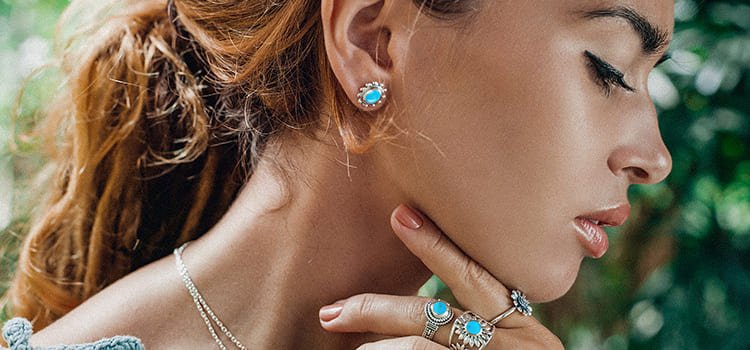Aspects, types and Tips to Know Value of Turquoise
Turquoise is a breathtakingly elegant gemstone with a unique combination of colors. It is a popular semi-precious stone and competes with others stones. In rare cases, it can be white or yellowish. The Turquoise Stone is soft as it ranges from 5 to 6 on the Mohs hardness scale. Its minerals may have a black pattern that resembles marble or spiderweb.
The occurrence and development of Turquoise stones take place after a chemical reaction between copper, phosphorus, and aluminum. It needs a dry and barren region with acidic groundwaters. Some prominent origin countries of turquoise are Afghanistan, China, Egypt, and Tibet.
It is a December birthstone and the lively Real Turquoise color undoubtedly improves the mood of anyone who is looking at it. As per the belief, this gemstone entices peace, attracts love, and shields the owner from all evil spirits. The stunning stone is known for its calming energy that can improve Feng Shui’s energy in one’s home. Maximum people across the world believe that it supports healing practices and the balancing of emotions.
The bright color of Turquoise grabs the attention of everyone who looks at it. The actual value of turquoise comes from the quality and rarity of the stone. It is a naturally soft and porous stone that bolsters damage in the cutting process. Only the rare and premium quality stones can be cut or shaped for designing Sterling Silver Turquoise Jewelry without any sort of enhancement. Wearing Turquoise Ring will promote physical health and boosts immunity.
Aspects that determine the Value of Turquoise
The crucial aspects that determine the value of Turquoise are Hardness of Turquoise, Esthetic Beauty, and Rarity. They contribute to figuring out the actual overall value of the stone and its details are as follows:
-
Hardness-
A small percentage of all turquoise mined is normally hard enough to be used in jewelry. In many cases as much as 90 percent of turquoise mined is chalky and soft would require stabilization to use. The finest quality turquoise that is naturally hard enough to be used is known as natural or untreated turquoise. This top tier of natural turquoise, has further categories such as high and gem-grade define the absolute best and hardest natural stones.
-
Esthetic Beauty-
The depth of stone color and the existence of host rock or matrix combining all of them can add value. Deep and darker colors are mostly expensive. Tight webbing in the matrix also enables to add of value to turquoise.
-
Rarity-
It is a major factor in terms of pricing as it relates to the Turquoise mines. The amalgamation of stone quality and their aesthetic beauty makes Lander Blue the most costly turquoise mine in the world.
Types of Turquoise commonly Sold
-
Natural:
Top-quality and unadulterated turquoise are correctly cut and polished. Check out for vibrant colors ranging from sky blue to green. All of these gems mostly have matrix veins or blotches that vary right from the area around Los Cerrillos, Grant County, and Mexico.
-
Treated or Stabilized:
Natural turquoise ranges from low to medium quality. The industry has established methods for improving the durability and hardness of less desirable turquoise by saturating softer stones with a colorless stabilizing compound.
-
Black Turquoise:
Crushed low-quality turquoise and turquoise dust that has been molded into blocks with colored plastics, cut, and polished. It is sometimes referred to or called as reconstituted turquoise or very commonly, ‘’brick’’. This kind of turquoise can often be identified by a strong ‘’plastic’’ scent.
Tips to determine Best Turquoise
Just like other gemstones, Turquoise has many attributes that define stone quality. Mostly, the professionals and experts evaluate turquoise based on its color, clarity, and carat weight. They are common C’s which are used to know diamond quality. Turquoise can have different shades of blue and green.
The stones with a green shade or have a lower value than those with blue; but also a matter of personal preference. Ideally, the color of turquoise must be even and intense. In turquoise clarity is all about the opaqueness level. It is never clear like glass, but it ranges from semi-translucent to opaque. High in terms of value thus tend to increase its cost. The turquoise stones have can have a black, brown, or golden pattern are known as Matrix.
Its fragment of rock surrounded the turquoise mineral in its natural environment. Matrix tends to make stone even more alluring and clear stones are valuable. Normally, turquoise has a cabochon cut – a smooth and rounded dome shape with a superb polish. This cut splendidly, reveals the stone’s even color and texture. The stones are available in all sizes and weighed in carats.
Some jewelry pieces promote an array of tiny stones while the remaining of them and most expensive pieces feature single large minerals. Turquoise has a comparatively low retail price, which results in lower resale value. That should not be any problem if you are planning to sell such an appealing piece of jewelry.
Conclusion
The entire article summarizes and tends to list out factors that determine the value of turquoise, types, and tips to know the premium quality of turquoise. To save from fraud it is mandatory to look out for companies that design and supply premium quality Wholesale Turquoise Jewelry.
Author Bio –
My name is Eva Cruz, and I love expressing my opinion through interesting writeups. I have had a great experience in writing over the last six years, which helped me understand the dynamics of creative writing. At Sanjay exports, I provide deep researched articles on the turquoise ring to enhance your knowledge of stones. Hope it gives you a perspective on the satisfying purchase of jewelry with quality and authenticity in every piece.


















